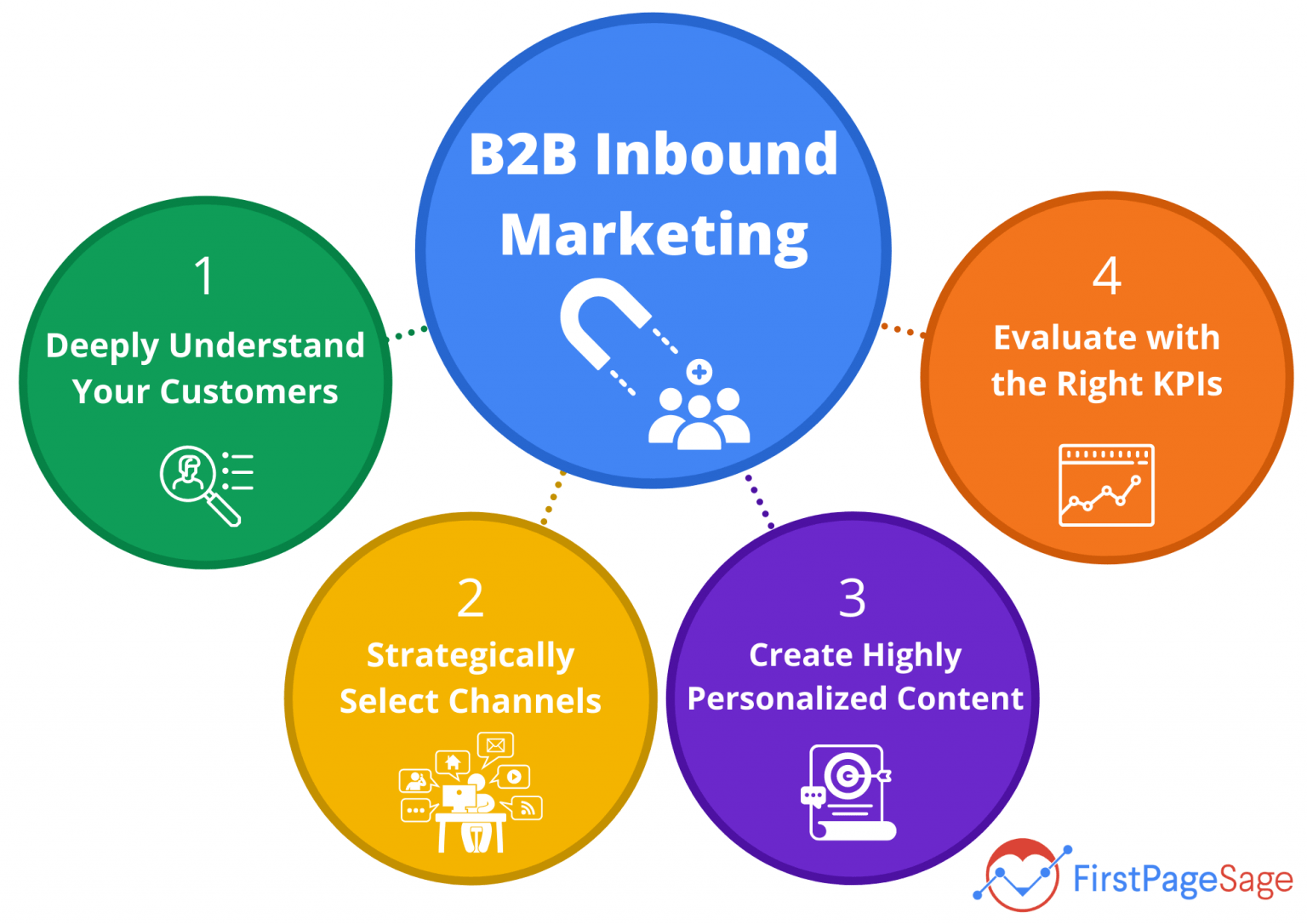
Home > 6 Essential Inbound Marketing Tactics for SaaS Products: A Guide
Table of Contents
ToggleEffective marketing is the linchpin for success in today’s competitive landscape of Software as a Service (SaaS) products.
While traditional outbound marketing tactics like cold calling and mass email blasts may still have their place, inbound marketing strategies are truly making waves in the industry.
Inbound marketing focuses on attracting and engaging prospects organically through valuable content.
To lay a solid foundation, it’s crucial to grasp the marketing funnel concept and the B2B sales cycle. The marketing funnel represents the customer journey, divided into stages: awareness, consideration, decision retention and advocacy.
On the other hand, the B2B sales cycle outlines the steps a prospect takes from the initial interest to becoming a customer.
Inbound marketing plays a pivotal role in both the marketing funnel and the B2B sales cycle. It enables SaaS businesses to build brand awareness, nurture leads, and establish trust, ultimately driving conversions and long-term customer loyalty.
This blog post will explore the importance of inbound marketing in the SaaS industry and outline six essential tactics to supercharge your marketing efforts. So, let’s dive in!

Inbound marketing is like a magnet that draws people to your business organically.
It helps you to create informative and valuable content that helps users understand your SaaS product better. This way, you don’t have to rely on spending thousands of dollars on pushy ads.
Instead of annoyingly pushing ads and interrupting folks, you create valuable content that they simply can’t resist. It’s all about being the helpful guide they need rather than the annoying salesperson they avoid.
Let’s bring it home with a SaaS example. Imagine you’ve developed an amazing SaaS product that helps businesses automate customer support processes. Now, you want to spread the word and attract those interested in streamlining their support operations.
Inbound marketing starts by creating compelling content that addresses the pain points and challenges your target audience faces. For instance, you could write a blog post titled “5 Ways to Boost Customer Support Efficiency with Automated Solutions.” This article provides actionable tips and insights that support teams crave to improve their productivity.
To maximize the impact, you can optimize your content with relevant keywords and make it super-easy for your potential customers to find. You want your blog post to pop up when they search for customer support efficiency. It’s like shining a spotlight on your valuable advice and expertise.
Once these curious visitors land on your website, you want to captivate them and keep them returning for more.
You see, inbound marketing is all about building a relationship and establishing yourself as a trusted advisor. You genuinely care about their success and aim to provide them with the knowledge and tools they need to thrive.
As you nurture these leads and they become more familiar with your brand, they’ll start seeing you as the go-to expert in the field.
And when they’re ready to make a purchase or take the next step, guess who they’ll turn to? Yep, that’s right—your SaaS solution will be at the top of their minds.
Here’s what our in-house experts have to say about inbound marketing:

Inbound marketing plays a vital role in supporting the various stages of the buyer’s journey, from initial awareness to final purchase. Let’s explore how inbound marketing aligns with each stage and helps guide potential customers along their journey:
– Buyers identify a problem or need they have.
– Create content to address their pain points and challenges-
-Buyers actively research possible solutions.
-Provide informative content, showcasing expertise and highlighting the unique features:
– Buyers evaluate different providers or products.
– Present compelling offers, such as free trials or demos, and leverages testimonials and customer reviews to build trust.
– The buyer’s journey doesn’t end with the purchase.
– Focus on customer satisfaction and retention, delivering relevant content, personalized recommendations, and ongoing support. Offer content like:
– Advocates and brand evangelists share your product with their friends and network because they believe in its value and benefits.
– Implement referral programs, provide easy-to-use social media sharing options, and offer discounts for successful referrals. Focus on content like:
✅ Establishes thought leadership
✅ Increases brand visibility
✅ Generates qualified leads
✅ Builds trust and credibility
✅ Supports customer retention and advocacy
✅ Cost-effective compared to traditional marketing
✅ Allows data-driven optimization
✅ Aligns with the modern buyer’s journey
SaaS inbound marketing can get a bit tangled in tech-speak, but guess what? It’s not as complicated as it seems!
Here’s the secret sauce: create killer content, shout it from the virtual rooftops, and tweak it to turbocharge conversions. Ready to unravel this marketing puzzle? Let’s dive in and make it happen!
In the competitive landscape of SaaS products, content marketing has emerged as a powerful strategy to attract, engage, and convert customers.
Content marketing involves creating and distributing valuable, relevant, and consistent content to attract and retain a clearly defined audience, ultimately driving profitable customer action. So, content marketing helps you to:
Identify the Target Audience
Develop Compelling Content
Content Distribution and Multi-channel Approach
Pro Tip: Understanding the modern buyer’s journey is crucial for effective marketing. It consists of awareness, consideration, decision, retention, and advocacy. Aligning your strategies with each stage drives engagement, loyalty, and business success.
Search Engine Optimization (SEO) has become critical to any successful SaaS marketing strategy. By optimizing your website and content for search engines, you can increase your visibility, attract relevant traffic, and ultimately drive conversions.
Keyword research is the foundation of successful SEO. Start by identifying keywords relevant to your SaaS product using tools like Google Keyword Planner or SEMrush. Consider these key steps:
Optimize your website’s on-page elements to improve its search engine visibility.
Creating high-quality, optimized content is crucial for driving organic traffic. Follow these best practices:
Also, focus on off-page optimization – building your website’s authority and reputation. Earn high-quality backlinks from reputable websites by creating unique content and reaching out to industry influencers or relevant publications. Contribute insightful articles to authoritative blogs in your niche, leveraging their audience and linking back to your website.
Measure the volume of traffic coming to your website through organic search. Monitor your keyword positions in SERPs to assess your visibility and track progress.
With millions of users scrolling through their feeds, social media presents a golden opportunity to connect with your target audience, showcase your SaaS offering, and build a community of loyal followers. Let’s break it down step by step!
First things first: developing a solid social media strategy is vital. Start by understanding your audience inside out.
Once you have that locked in, set clear goals for your social media efforts, like are you looking to increase brand awareness, drive traffic to your website, or generate leads?
Define your objectives and track your progress along the way.
Now, onto creating engaging and shareable content. Remember, content is king! Be the solution to your audience’s problems. Share valuable insights, tips, and tricks to make their lives easier.
For example, if you have a project management SaaS tool, create content that showcases how it helped a remote team skyrocket its productivity or offer tips for effective project management in a distributed work environment.
And don’t forget to spice up your content with visually appealing graphics, videos, and images to catch those scrolling eyes.
Building a community of followers is where the magic happens. Be responsive. Engage with your audience by responding to comments, messages, and mentions. Show that you genuinely care about their thoughts and concerns.
Encourage user-generated content where your followers can share their experiences with your SaaS product. And there’s nothing more powerful than authentic testimonials from satisfied customers.
To take your SaaS game to the next level, pay close attention to these tried-and-true techniques. Let’s get started!
Segmented Email Lists: There is no one-size-fits-all approach when it comes to email marketing. That’s why creating segmented email lists is a game-changer. Break down your audience based on their interests, behaviors, needs, pain points, or demographics.
For example, if you have a project management SaaS, you can create separate segments for freelancers, small businesses, and enterprise clients. This way, you can tailor your emails to resonate with each group, thus increasing open rates and engagement.
And don’t forget to track those performance metrics!
Dive into open rates, click-through rates, and conversion rates to measure the effectiveness of your campaigns. This data will guide your future email marketing efforts and help you optimize for success.
And remember:
Optimizing your conversion rates is a game-changer for your SaaS business. It’s not just about driving traffic to your website or landing pages; it’s about transforming those visitors into loyal and paying customers. By focusing on conversion rate optimization (CRO), you can maximize the return on your marketing efforts and enhance the overall user experience.
A/B testing is a powerful technique that allows you to compare different versions of your landing pages, CTAs, or website copy.
Friction kills conversions.
To optimize your conversion rates, identify obstacles or complexities that might impede the sign-up or purchase process.
Data is your compass in the CRO journey. Continuously monitor and analyze conversion data to uncover valuable insights. Dive into analytics tools, track conversion funnels, and identify drop-off points.
Look for patterns and trends that reveal user behavior and preferences. This data-driven approach enables you to make informed decisions and optimize conversion rates effectively.
When it comes to inbound marketing, automation is a secret weapon that can supercharge your efforts. Imagine automating lead capturing, segmenting your audience, and nurturing prospects with personalized content. Marketing automation platforms like HubSpot, Marketo, and Pardot make this a reality.
With these tools, you can seamlessly engage leads at the right moment with content tailored specifically to their needs. This not only boosts conversions but also enhances customer satisfaction.
For B2B inbound marketing, automation takes on even greater importance as B2B sales cycles can be complex, involving multiple touchpoints and decision-makers. How, you ask?
Marketers can effectively track and manage prospect interactions throughout the sales funnel by leveraging tools like CRM systems and lead-scoring software. Automation allows for efficient lead qualification, personalized communication, and faster conversion.
To achieve effective automation, you need the right tools in your arsenal. Marketing automation platforms offer comprehensive solutions for managing and automating various marketing activities.
Think of them as your marketing sidekick, helping you capture leads, segment your audience, and deliver personalized experiences.
Email marketing tools like Mailchimp and Sendinblue also enable you to manage campaigns and personalize communication efficiently. And let’s not forget CRM systems like Salesforce and Zoho CRM, which provide robust automation capabilities to seamlessly align your sales and marketing efforts.
Mastering the three pillars of SaaS inbound marketing—creating high-quality content, promoting it effectively, and optimizing for conversions—can pave the way for a steady flow of leads. Consistency, both in quality and quantity, is paramount to success.
As the significance of inbound marketing continues to skyrocket for SaaS businesses, it’s crucial to invest in this strategy now.
If you’re already in the game, consider leveraging professional services and conducting extensive market research to solidify your position. Stay focused, stay valuable, and watch your SaaS business thrive.
Rajashree Goswami
I tweak my ideas and thoughts to create creative & narrative SaaS content. At FPGrowth, as Lead Content Writer, I underpin solutions into words, and put the assessments into threaded paragraphs to solve the readers' pain points. When not on my table, you can find me roaming around nature with...